
The ODROID-C4 is a new generation single board computer that is more energy efficient and has higher performance than the ODROID-C2 which was introduced over four years ago, as the world's first affordable ARM 64-bit computer. The ODROID-C4 features an Amlogic S905X3 CPU which is a quad-core Cortex-A55 cluster with a new generation Mali-G31 GPU. The A55 cores run at 2.0Ghz without thermal throttling using the stock heat sink, allowing a robust and quiet computer. The multi-core performance is around 40% faster, and the system DRAM performance is 50% faster than the ODROID-C2.
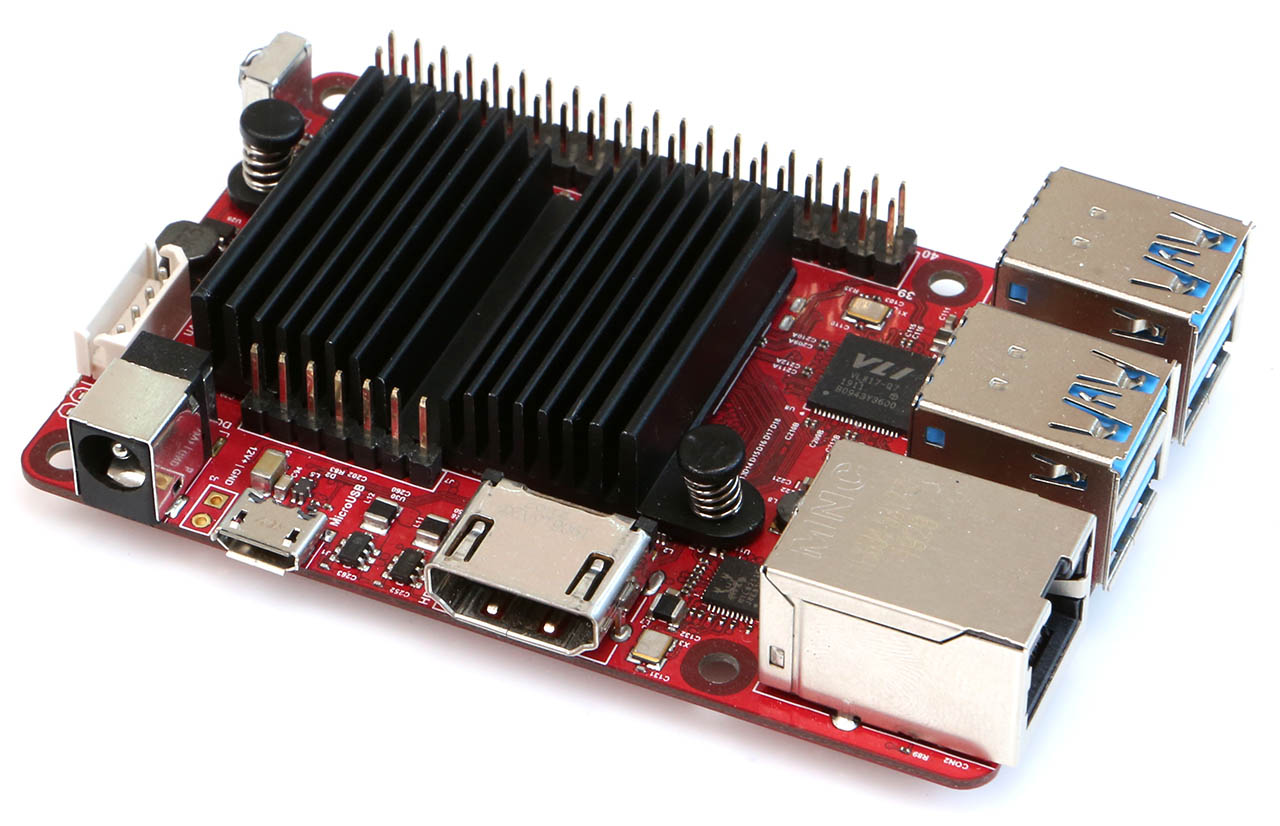
Let's look at the block diagram and the key components of the board in Figures 2 and 3 to learn more about the hardware features.
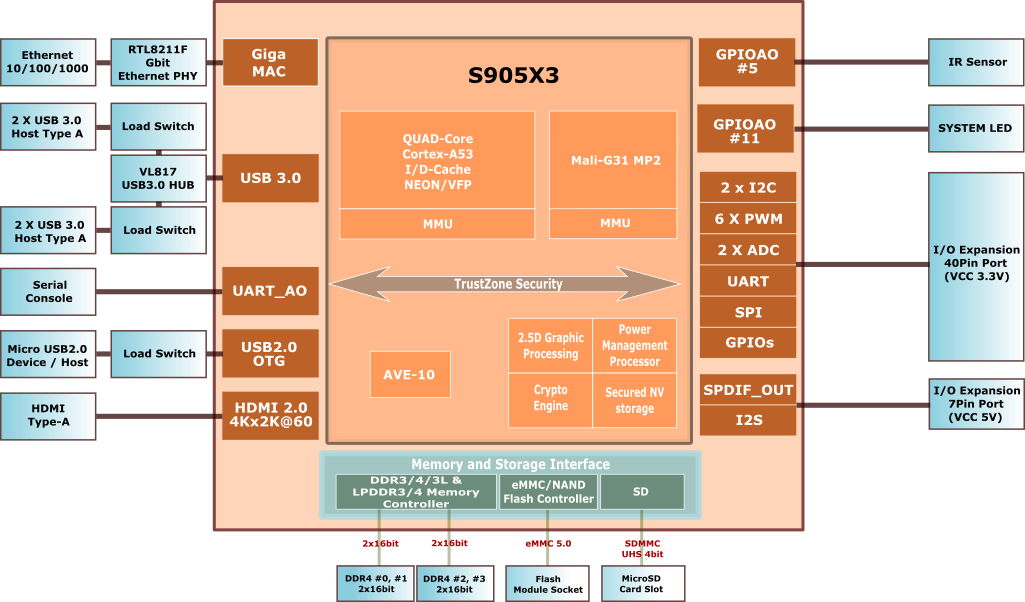

More detailed hardware information is available on the ODROID-C4’s wiki at https://wiki.odroid.com/odroid-c4/hardware/hardware.
CPU performance
Dhrystone-2, Double-Precision Whetstone, 7-zip compression benchmark results show that the ODROID-C4 system performance is 40 ~ 55% faster than the previous generation ODROID-C2.
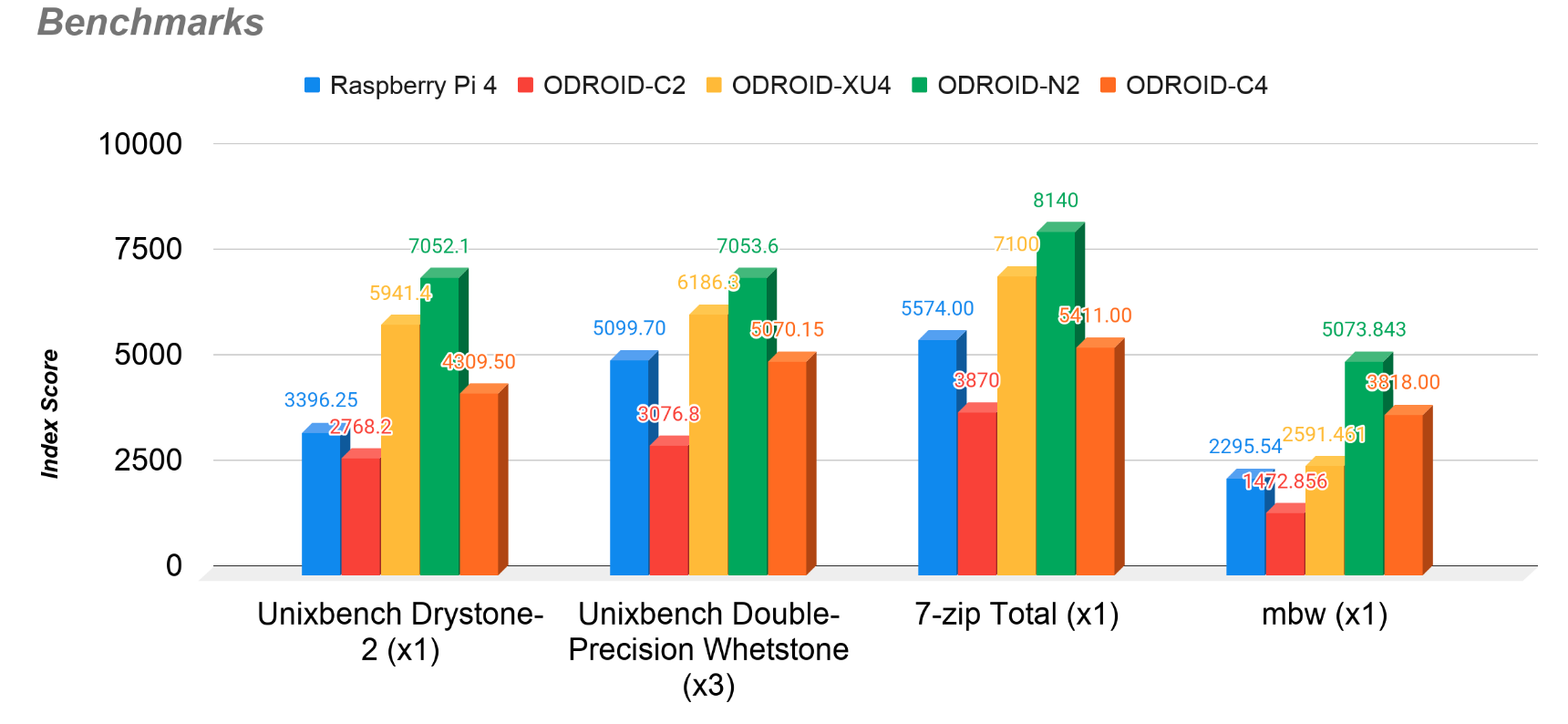
GPU performance
The Mali-G31 runs at 650MHz and is ~50% faster than Mali-450MP in ODROID-C2. The Mali-G31 is the first generation Bifrost-based mainstream GPU from Arm. GPU performance was measured using glmark2-es2 “--off-screen”.
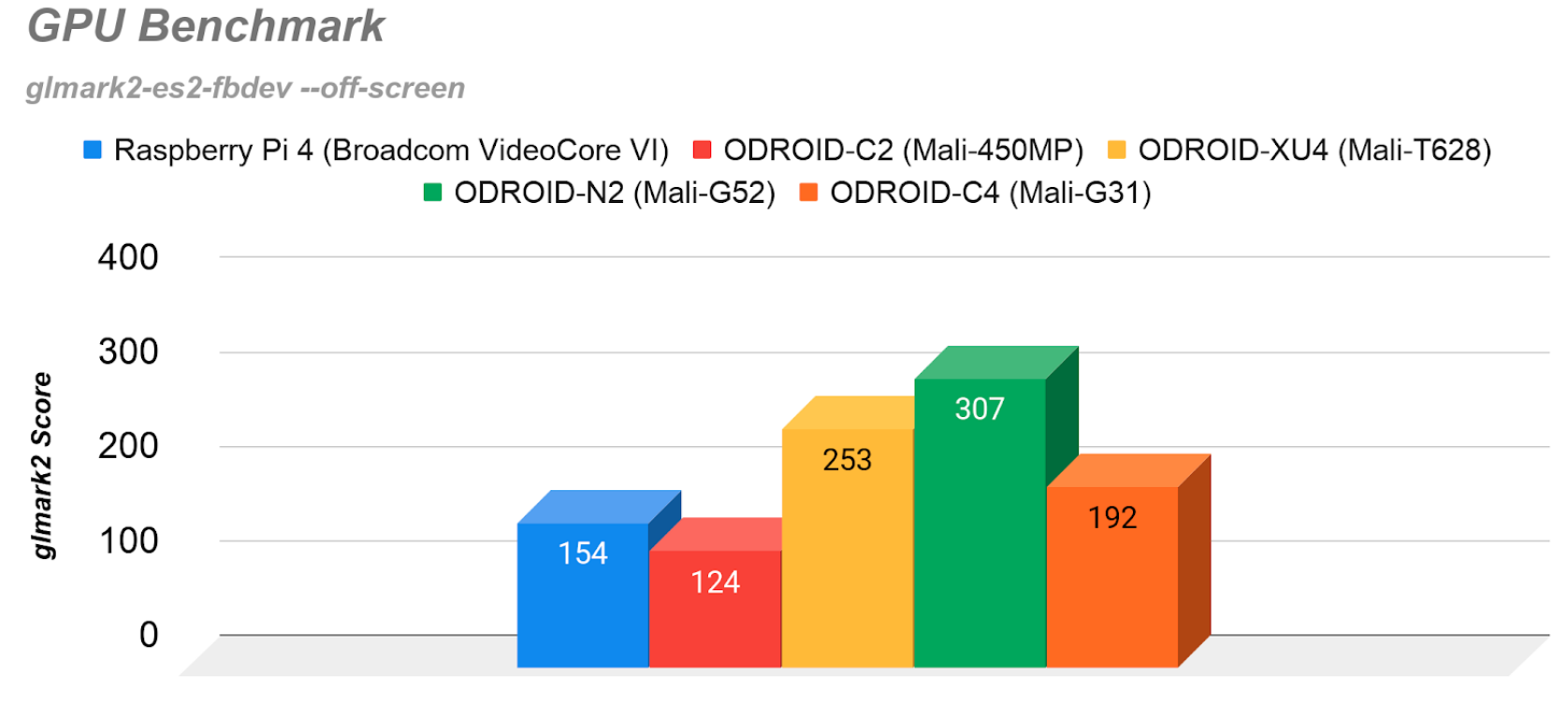
RAM performance
Why does DDR4 matter? The ODROID-C4 DDR4 RAM runs at 1320Mhz, with a memory bandwidth that is 1.6 times higher than the ODROID-C2.
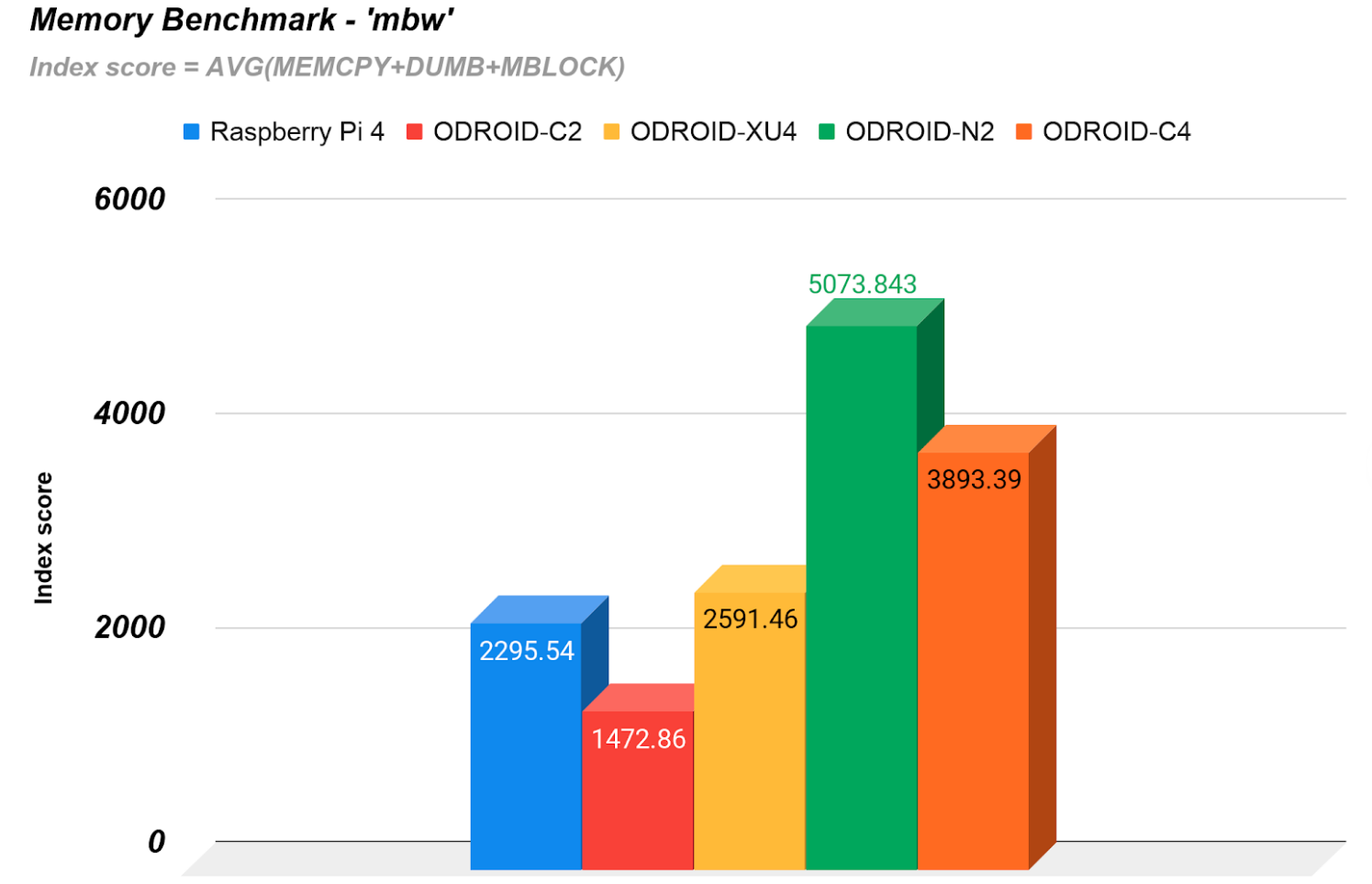
CPU frequency vs performance
Some ODROID users may recall the lower than expected clock speed with ODROID-C2’s S905. We ran a test to confirm the ratio between CPU clock frequency and performance with ODROID-C4.

Thermal characteristics
To check thermal throttling, we ran some heavy CPU and GPU loads together on the SoC and monitored the temperature within a chamber that maintains the ambient temperature at 25°C. Note that the current thermal throttling point is set at 75°C in the Kernel configuration.
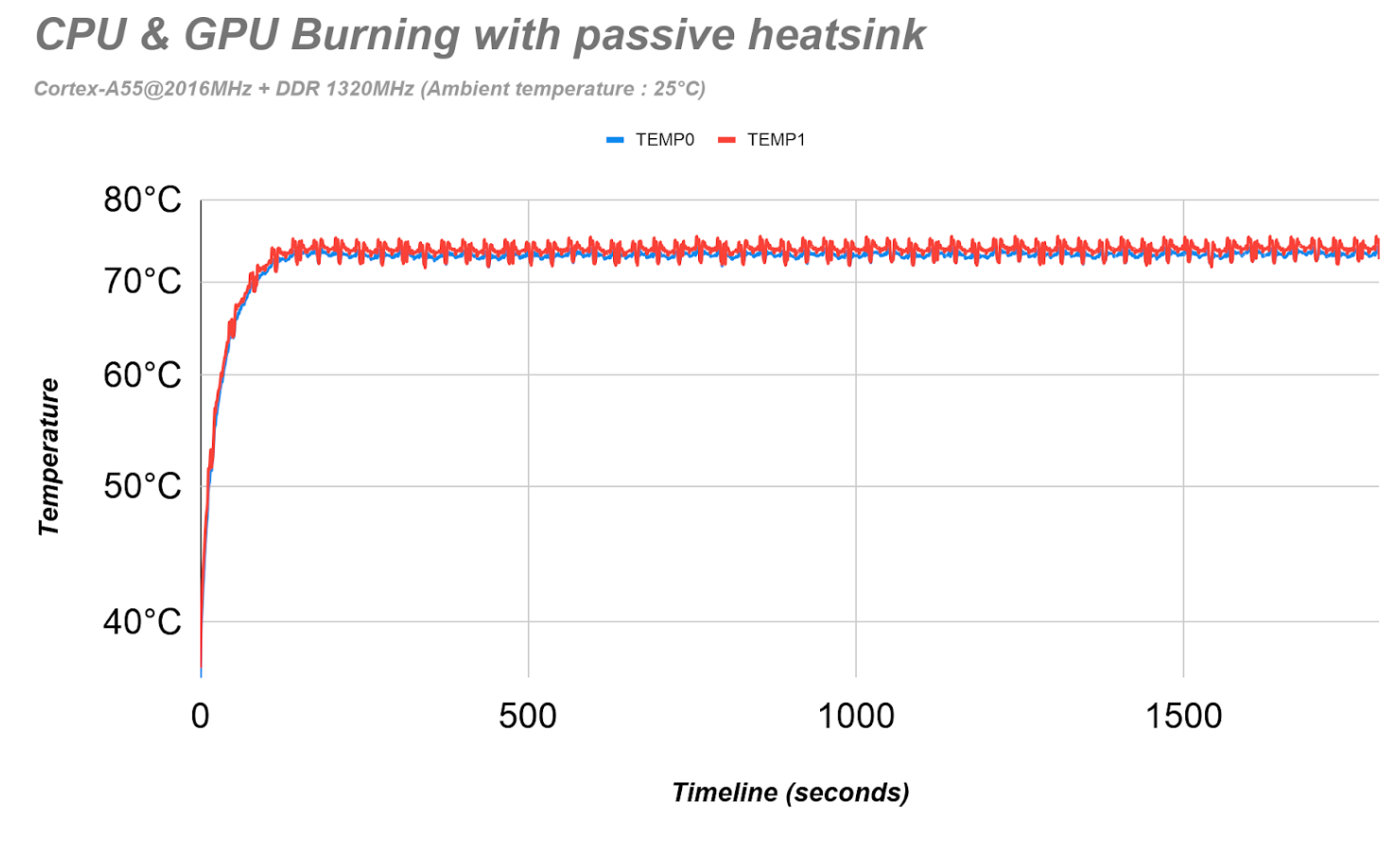
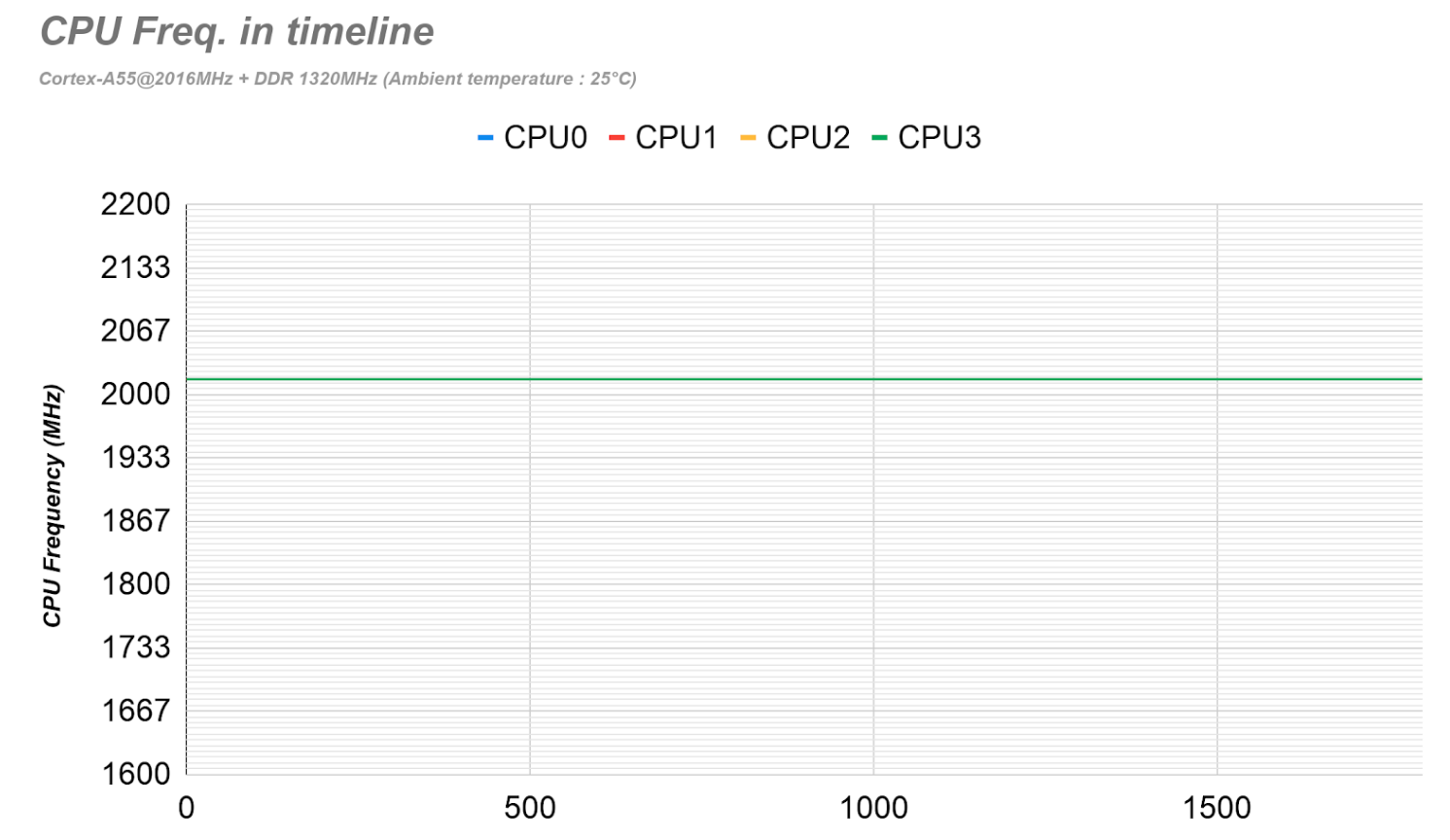
If you put the ODROID-C4 board into an enclosure, you may encounter some thermal throttling issues when the ambient temperature is higher than 20°C and the continuous computing load is very high.
Ethernet
According to our iperf test result, the throughput performance was near 1Gbps.
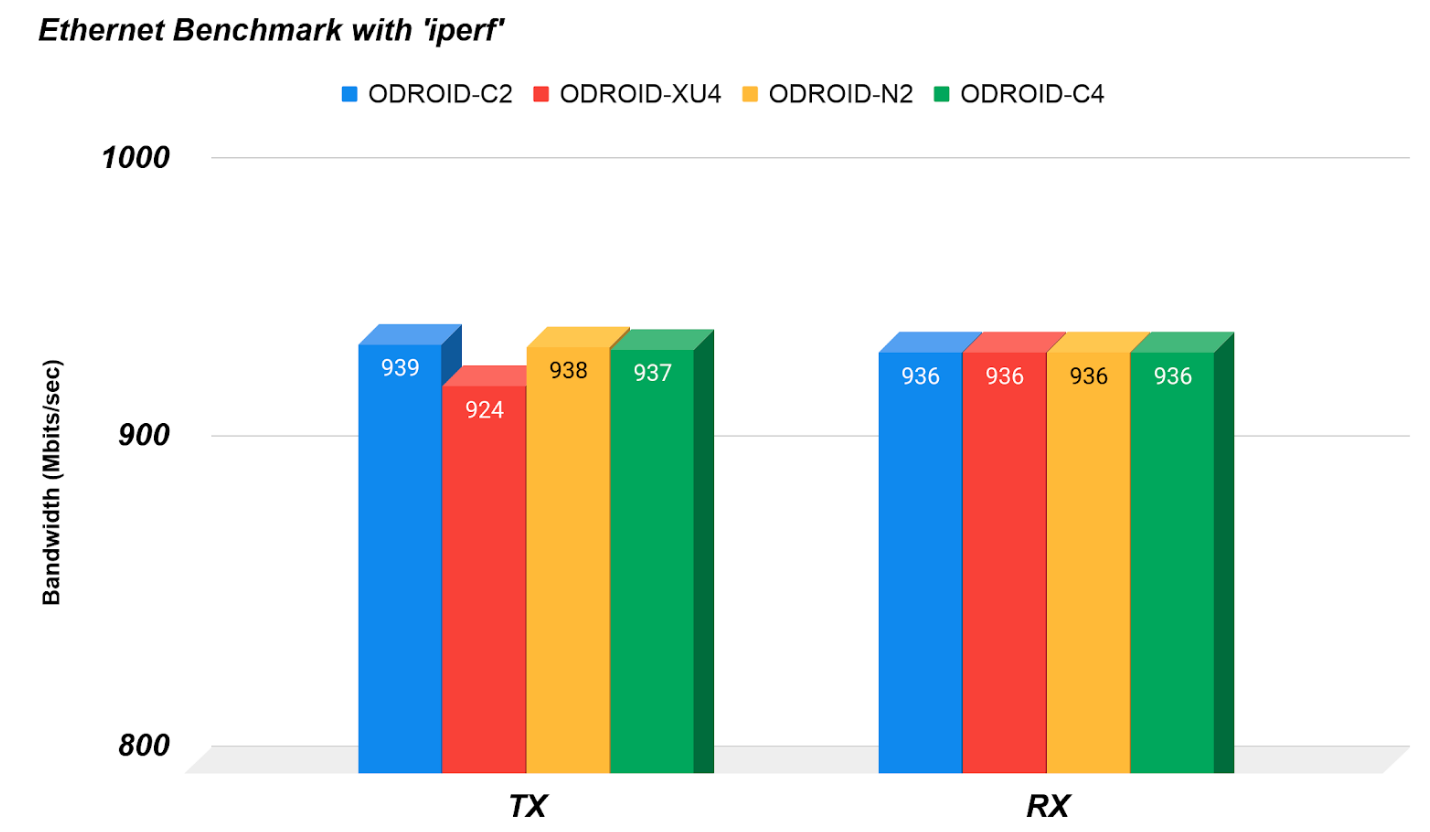
USB Port
We measured the USB3 transfer speed with a USB SSD. The average ~340MB/s of throughput should be acceptable for many applications. Since four USB host ports share a single root hub, the transfer rate will be lower if you use multiple USB3 devices at the same time. There is a separate micro-USB port to support the USB 2.0 OTG dual-role interface, too.
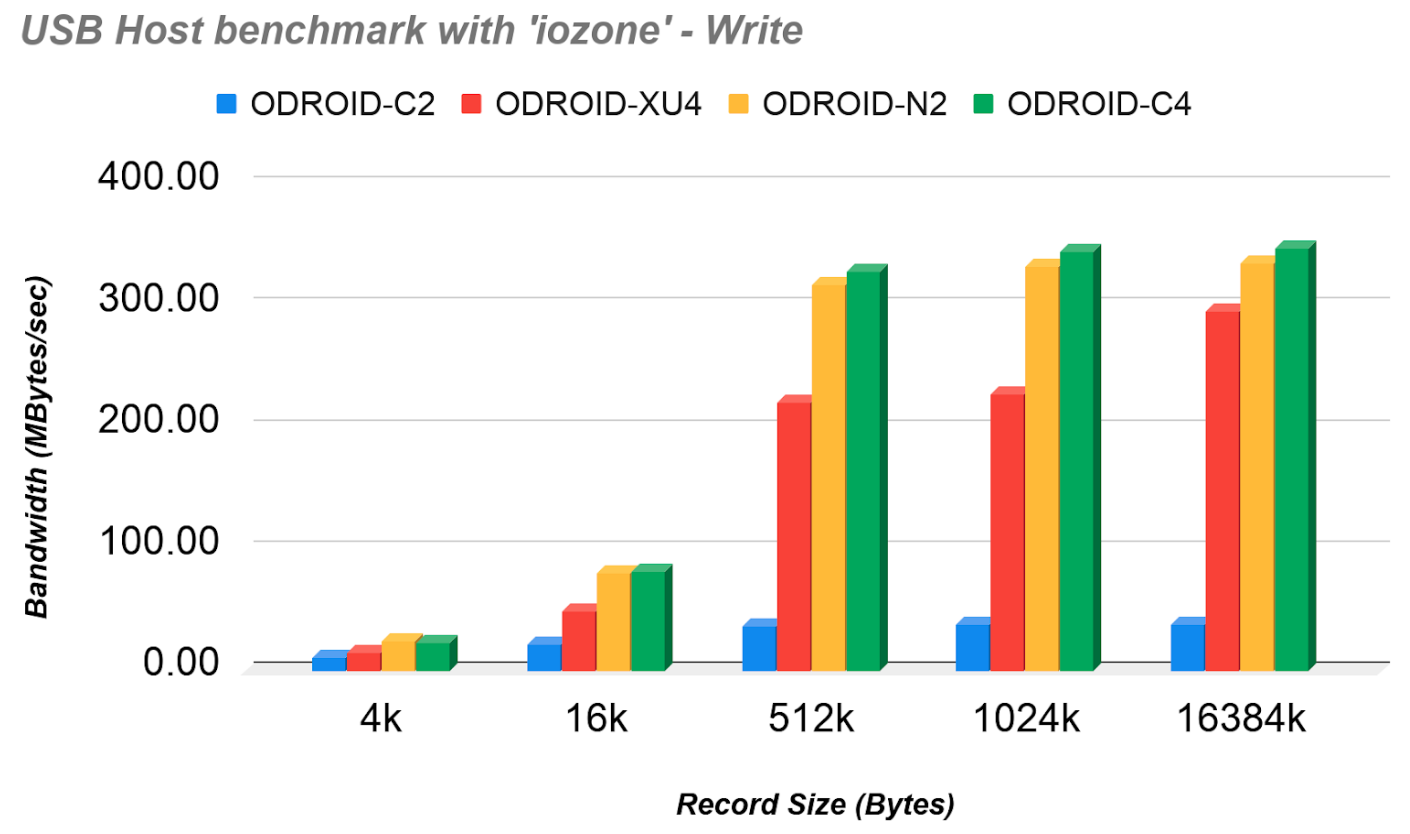
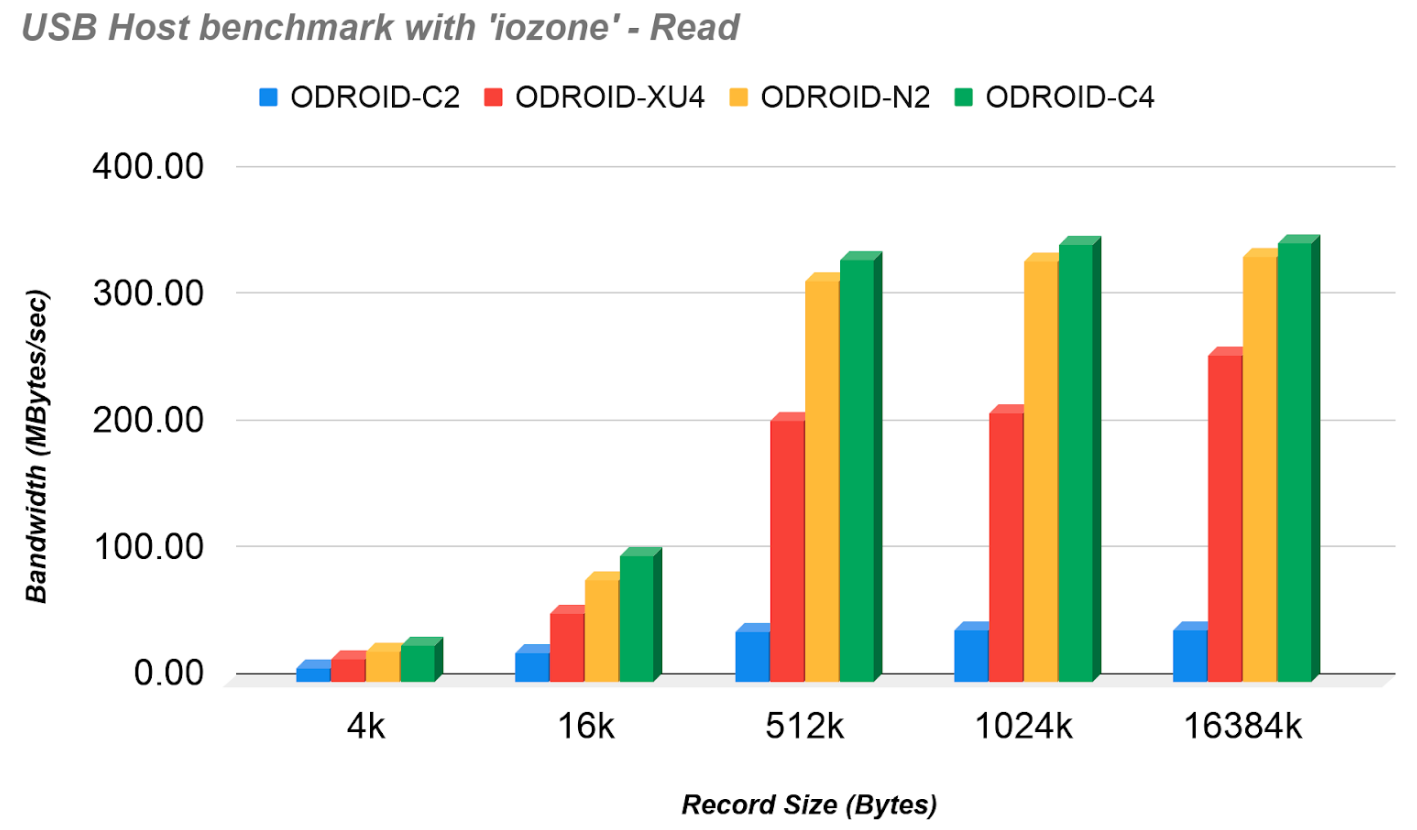
eMMC storage performance
Sequential read and write speed is over 165MB/s and 125MB/s respectively. The 4K random access performance is reasonably fast, too. The iozone test results are as follows.

Micro-SD UHS performance
Using properly implemented UHS dynamic voltage scaling, the sequential read and write speed is over 70MB/s and 50MB/s, respectively.

Cryptography
The ARMv8 architecture supports hardware accelerated crypto extensions for building a secure system. As expected, we could see very strong openSSL performance with ODROID-C4.
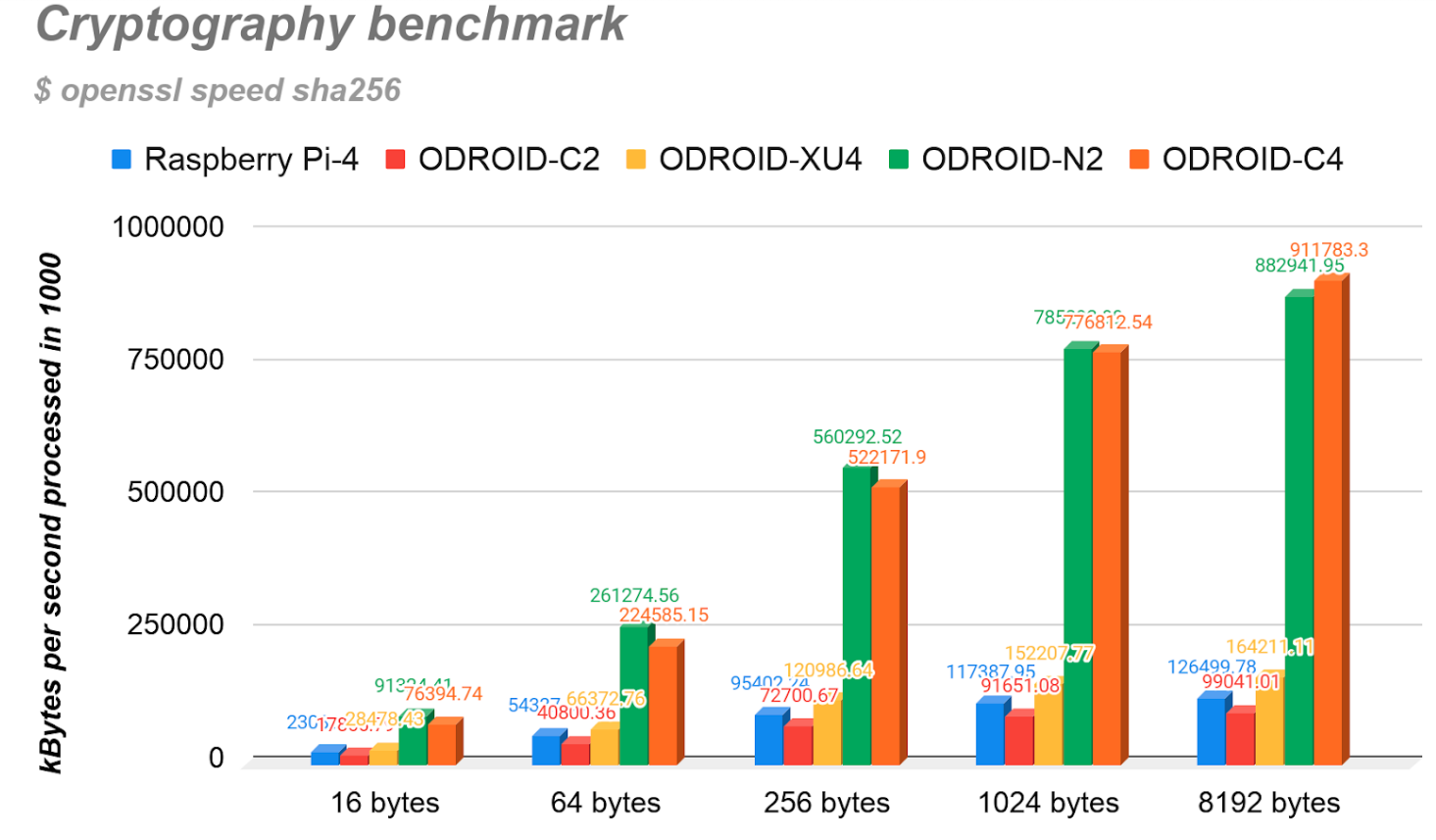
GPIO (40Pin Header)
The ODROID-C4 GPIO interface is similar to the ODROID-C2 and fully supports a 3.3 Volt interface. This is beneficial for using various peripherals without complicated level shifters as needed with the ODROID-XU4’s 1.8Volt GPIOs. Another big improvement is a faster SPI bus interface with a maximum frequency of over 100Mhz. It is significantly faster than the ODROID-C2’s 400Khz software “bit-banged” SPI.
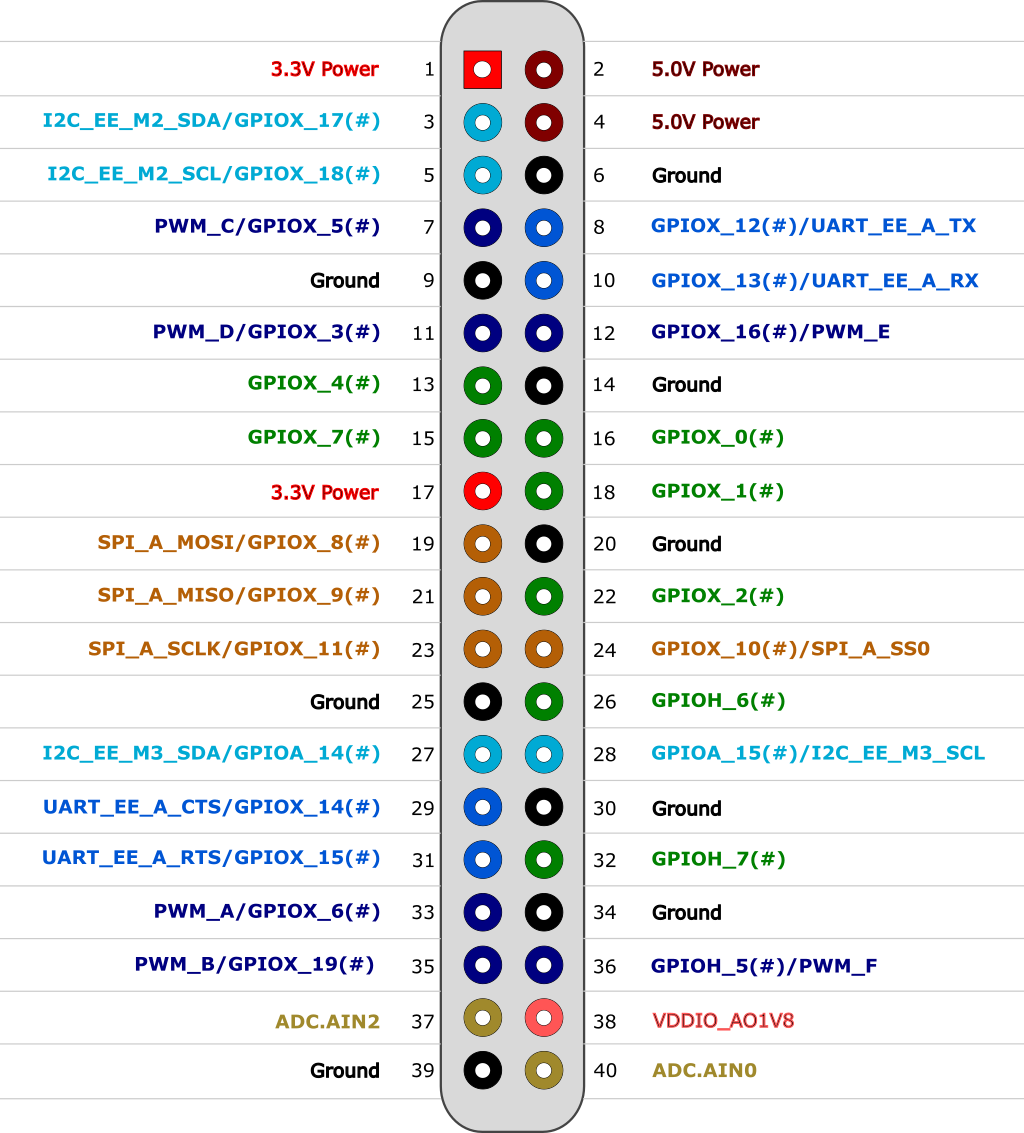
Power consumption
Thanks to the modern 12nm fabricated S905X3 CPU, the power consumption and heat dissipation are very low, allowing you to enjoy a quiet and powerful computer with high energy efficiency.
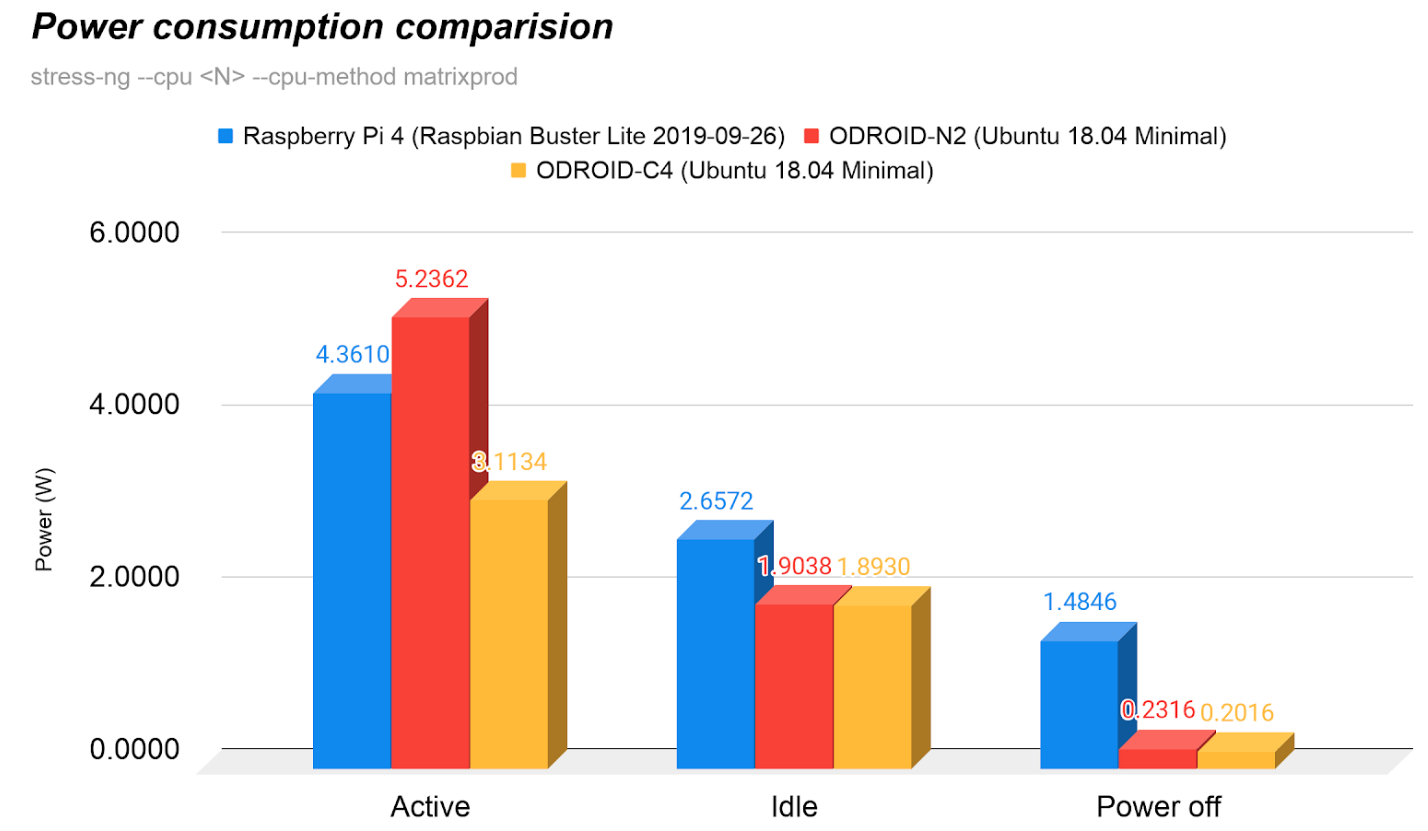
Idle state: ≃ 0.18 Watt Heavy load state: 3.1~3.3 Watt (stress-ng --cpu 4 --cpu-method matrixprod) No cables are attached except DC power input and USB-UART debug console cable.
The power consumption in “IDLE” is measured when a device is not being operated for 5 minutes since the CPU governor is set to “performance”. The measured power consumption is not absolute and could vary according to certain conditions.
Linux Software Support
An Ubuntu 20.04 LTS (full 64-bit) image is available with Linux kernel version 4.9.218 LTS as of April 22, 2020. This LTS kernel version will be officially supported until January 2023. A hardware accelerated video decoder (VPU) driver is available now. We have c2play and kplayer examples which can play 4K/UHD H.265 60fps videos smoothly on the framebuffer of the ODROID-C4’s HDMI output. The Mali G31 GPU Linux driver works only on the framebuffer as well.
Upstream Linux kernel 5.4 is also available for cutting-edge development supporting ARM Mali GPU acceleration. WebGL content can run on the Firefox browser (v75+) using the modern Wayland/GBM backend. However, the VPU acceleration is a work in progress. The Wayland powered Ubuntu 20.04 GNOME Desktop runs quite smoothly, as shown at https://youtu.be/4MfHMKcHaUc.
The Flutter UI framework is powered by an upstream Linux kernel 5.4 and is ARM Mali GPU accelerated, the Home Automation example is supplied as a real world embedded Linux system development reference. There is a demo video with Ubuntu 20.04 Minimal + Linux kernel 5.4 + Flutter UI + direct GPIO access at https://youtu.be/p6bzmdAJqjo.
Android Software Support
Android 9 “Pie” 64-bit is available, and we will release a full source code BSP and pre-built image together. Android user land supports 32-bit as well as 64-bit applications with a Vulkan capable ARM Mali GPU driver. Another big improvement is to support the AndroidThings compatible framework, this will provide an easy development environment to control hardware peripherals on Android using powerful Java APIs. The ODROID-C4 is not a Google AndroidThings-certified device, and Hardkernel’s Android source code does not include the Google AndroidThings source code.
A demo video of Android 64-bit and Vulkan GPU driver demo with PPSSPP “God of War” emulation is available at https://youtu.be/0o-JLCLlGe4. A demo of the Android IoT programming with AndroidThings compatible APIs may be seen at https://youtu.be/C5o7JCQXpr8.
LineageOS
LineageOS 16.0 is another community driven OS, and is available as of April 22, 2020. LineageOS 17.1 is currently being developed, and the very first version would be available in the middle of May, 2020.
CoreELEC
The CoreELEC development team created an amazing OS image for playing 4K/UHD content with HDR color support. The team offers a “just enough OS” Linux distribution designed for an optimal Kodi experience when running on popular Amlogic hardware. A 4K HDR + Audio Pass-through, Netflix 1080p and even 8K-30FPS H.265 video playback is possible with downscaling (https://youtu.be/7ejYL5OuMi0).
Availability and price
The ODROID-C4 is currently available for sale, and orders are being accepted. We will start shipping on April 28th. The ODROID-C4 4GB model is priced at $50, and is available directly from Hardkernel at https://www.hardkernel.com/shop/odroid-c4/. Other worldwide distributors will start selling soon, as shown at https://www.hardkernel.com/distributors/.
Where is the ODROID-C3?
We internally developed the ODROID-C3 based on the S905X2 CPU, which has ARM Cortex-A53 cores, almost two years ago. However, the performance was not good enough, and we had heard about the new upcoming S905X3 with modern ARM Cortex-A55 cores. Therefore, we decided to skip the ODROID-C3.
What about the ODROID-C2/C1+?
We will try and continue the production of ODROID-C2/C1+ for as long as possible, since there are still many B2B customers who continue to purchase them in quantity. However, Amlogic is discontinuing the old S905 and S805 CPUs in the near future, and as a result, we will likely have to discontinue ODROID-C2/C1+ early next year. Please consider switching to the new ODROID-C4 platform as soon as possible.
To view the original announcement, please visit the Hardkernel Wiki article at https://wiki.odroid.com/odroid-c4/odroid-c4.

Be the first to comment